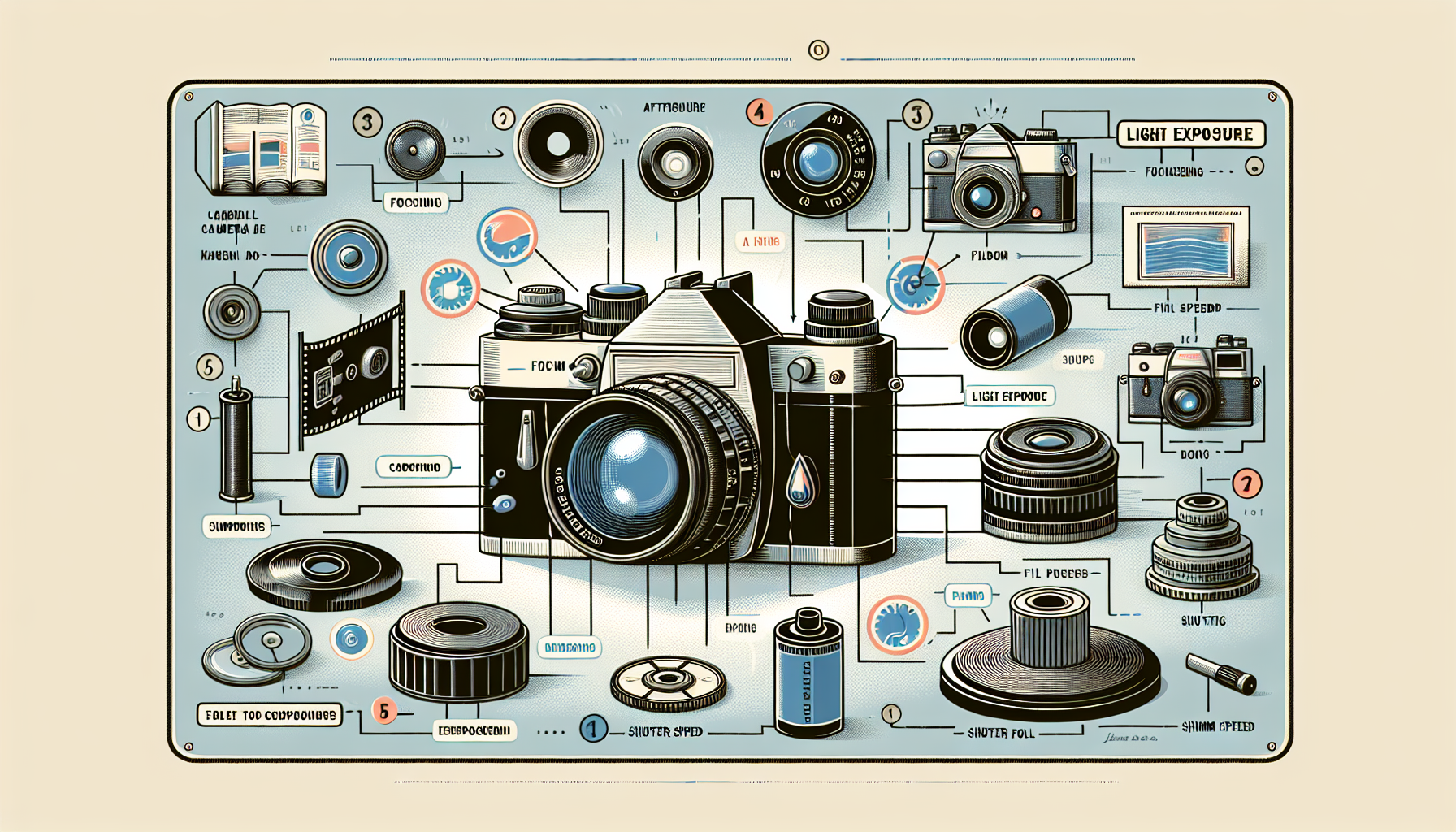
Mastering the Camera
Understanding and mastering the camera is essential for creating professional and impactful visuals. Whether you’re a beginner or an experienced filmmaker, knowing your camera and how to use it effectively is the key to capturing stunning content. Here’s a comprehensive guide:
Introduction to Camera Types and Settings
Cameras come in various types, each suited for specific purposes. Here are the main categories:
- DSLRs and Mirrorless Cameras: Ideal for professional photography and videography with interchangeable lenses and manual settings.
- Action Cameras: Compact and durable, perfect for capturing adventurous or outdoor footage.
- Smartphone Cameras: Convenient and increasingly advanced, great for quick and portable shooting.
- Camcorders: Designed for longer recording sessions, often used in event videography.
Key Camera Settings
- ISO: Controls the camera’s sensitivity to light. Use low ISO for bright conditions and higher ISO for low-light environments.
- Shutter Speed: Determines how long the camera’s shutter remains open. Use faster speeds for sharp, action shots and slower speeds for motion blur effects.
- Aperture (f-stop): Controls the amount of light entering the lens and the depth of field. A lower f-stop creates a blurred background, while a higher f-stop keeps more in focus.
- White Balance: Adjusts the color temperature to match the lighting conditions for accurate colors.
Basics of Framing, Angles, and Composition
Good framing and composition make your visuals more engaging. Follow these guidelines:
- Rule of Thirds: Divide the frame into a 3×3 grid and place your subject along the grid lines or intersections for balanced composition.
- Leading Lines: Use natural lines like roads or fences to guide the viewer’s eye to the subject.
- Angles:
- High Angle: Makes the subject appear smaller or more vulnerable.
- Low Angle: Gives the subject a sense of power or dominance.
- Eye Level: Creates a neutral and relatable perspective.
- Depth and Layers: Add depth by including foreground, middle ground, and background elements.
Lighting Tips for Different Scenarios
Lighting is a critical element that can dramatically impact the quality of your visuals. Here are tips for various scenarios:
- Natural Light: Shoot during the “golden hour” (early morning or late afternoon) for soft, warm lighting.
- Indoor Lighting: Use softbox lights or ring lights to minimize harsh shadows. Avoid mixed light sources that can cause uneven color balance.
- Low-Light Conditions: Use a wide aperture, higher ISO, and a tripod to prevent camera shake.
- Backlighting: Place the light source behind your subject for silhouettes or dramatic effects.
Capturing High-Quality Audio
Great visuals can lose their impact if the audio quality is poor. To ensure clear and professional sound:
- Use an External Microphone: Built-in microphones often pick up ambient noise. Shotgun, lavalier, or condenser mics are excellent options.
- Monitor Audio Levels: Keep levels consistent to avoid distortion or too-low sound.
- Minimize Background Noise: Choose a quiet location or use noise reduction techniques during post-production.
- Wind Protection: Use a windscreen or “dead cat” for outdoor shoots to prevent wind noise.
Conclusion
Mastering the camera involves understanding its types, settings, and the principles of composition, lighting, and audio. With practice and attention to detail, you can elevate your content to a professional level and effectively convey your creative vision.
کیمرہ مہارت حاصل کرنا
کیمرے کو سمجھنا اور اس پر مہارت حاصل کرنا پیشہ ورانہ اور متاثر کن ویژولز بنانے کے لیے ضروری ہے۔ چاہے آپ نئے ہوں یا تجربہ کار فلمساز، کیمرہ جاننا اور اسے مؤثر طریقے سے استعمال کرنا شاندار مواد بنانے کی کنجی ہے۔ یہاں ایک جامع رہنما پیش کیا گیا ہے:
کیمرے کی اقسام اور سیٹنگز کا تعارف
کیمرے مختلف اقسام کے ہوتے ہیں، ہر ایک مخصوص مقاصد کے لیے موزوں ہے۔ یہاں اہم اقسام ہیں:
ڈی ایس ایل آر اور مررلیس کیمرے: پیشہ ورانہ فوٹوگرافی اور ویڈیوگرافی کے لیے بہترین، جن میں لینز تبدیل کرنے کی سہولت اور دستی سیٹنگز ہوتی ہیں۔
ایکشن کیمرے: چھوٹے اور مضبوط، مہم جوئی یا باہر کی فلم بندی کے لیے بہترین۔
اسمارٹ فون کیمرے: آسان اور جدید، جلدی اور پورٹیبل شوٹنگ کے لیے زبردست۔
کیمرہ کورڈرز: طویل ریکارڈنگ کے لیے بنائے گئے، عام طور پر ایونٹ ویڈیوگرافی میں استعمال ہوتے ہیں۔
اہم کیمرہ سیٹنگز
آئی ایس او: کیمرے کی روشنی کو محسوس کرنے کی صلاحیت کو کنٹرول کرتا ہے۔ روشن حالات کے لیے کم آئی ایس او اور کم روشنی کے لیے زیادہ آئی ایس او استعمال کریں۔
شٹر اسپیڈ: کیمرے کے شٹر کے کھلنے کا وقت طے کرتا ہے۔ تیز اسپیڈز ایکشن شاٹس کے لیے اور سست اسپیڈز موشن بلر کے لیے استعمال کریں۔
اپرچر (ایف اسٹاپ): لینز میں داخل ہونے والی روشنی اور گہرائی کو کنٹرول کرتا ہے۔ کم ایف اسٹاپ دھندلا پس منظر بناتا ہے، جب کہ زیادہ ایف اسٹاپ زیادہ چیزوں کو فوکس میں رکھتا ہے۔
وائٹ بیلنس: روشنی کے حالات کے مطابق رنگوں کی درستی کے لیے ایڈجسٹ کرتا ہے۔
فریمنگ، اینگلز، اور کمپوزیشن کی بنیادی باتیں
اچھی فریمنگ اور کمپوزیشن آپ کے ویژولز کو زیادہ دلکش بناتی ہیں۔ ان اصولوں پر عمل کریں:
رول آف تھرڈز: فریم کو 3×3 گرڈ میں تقسیم کریں اور اپنے موضوع کو گرڈ لائنز یا ان کے چوراہوں پر رکھیں۔
لیڈنگ لائنز: قدرتی لکیروں جیسے سڑکوں یا باڑوں کا استعمال کریں تاکہ ناظرین کی نظر کو موضوع تک پہنچایا جا سکے۔
اینگلز:
ہائی اینگل: موضوع کو چھوٹا یا کمزور دکھاتا ہے۔
لو اینگل: موضوع کو طاقتور یا غالب بناتا ہے۔
آئی لیول: ایک غیر جانبدار اور متعلقہ نقطہ نظر پیدا کرتا ہے۔
گہرائی اور پرتیں: گہرائی شامل کرنے کے لیے پیش منظر، درمیانی زمین، اور پس منظر کے عناصر کو شامل کریں۔
مختلف حالات کے لیے روشنی کے نکات
روشنی ایک اہم عنصر ہے جو آپ کے ویژولز کے معیار کو نمایاں طور پر متاثر کر سکتا ہے۔ مختلف حالات کے لیے نکات:
قدرتی روشنی: نرم اور گرم روشنی کے لیے “سنہری گھنٹے” (صبح جلدی یا شام دیر) میں شوٹنگ کریں۔
ان ڈور لائٹنگ: ہارڈ شیڈوز کو کم کرنے کے لیے سافٹ باکس لائٹس یا رنگ لائٹس استعمال کریں۔ مختلف روشنی کے ذرائع سے بچیں جو رنگوں کو غیر متوازن بنا سکتے ہیں۔
کم روشنی کے حالات: وسیع اپرچر، زیادہ آئی ایس او، اور ٹرائیپوڈ استعمال کریں تاکہ کیمرے کی حرکت کو روکا جا سکے۔
بیک لائٹنگ: اپنے موضوع کے پیچھے روشنی کا ذریعہ رکھیں تاکہ سلہوٹس یا ڈرامائی اثرات پیدا ہوں۔
اعلی معیار کی آڈیو کیپچر کرنا
اچھے ویژولز کا اثر ختم ہو سکتا ہے اگر آڈیو کا معیار خراب ہو۔ صاف اور پیشہ ور آواز کو یقینی بنانے کے لیے:
ایک بیرونی مائیکروفون استعمال کریں: بلٹ ان مائیکروفون اکثر پس منظر کا شور ریکارڈ کرتے ہیں۔ شاٹ گن، لیویلئیر، یا کنڈنسر مائیکروفون بہترین اختیارات ہیں۔
آڈیو لیولز کی نگرانی کریں: سطحوں کو مستقل رکھیں تاکہ ڈسٹورشن یا بہت کم آواز سے بچا جا سکے۔
پس منظر کے شور کو کم کریں: ایک پرسکون جگہ کا انتخاب کریں یا پوسٹ پروڈکشن کے دوران شور کو کم کرنے کی تکنیک استعمال کریں۔
ونڈ پروٹیکشن: باہر کی شوٹنگ کے لیے ونڈ اسکرین یا “ڈیڈ کیٹ” استعمال کریں تاکہ ہوا کے شور کو روکا جا سکے۔
اختتام
کیمرہ کی مہارت حاصل کرنے میں اس کی اقسام، سیٹنگز، اور کمپوزیشن، روشنی اور آڈیو کے اصولوں کو سمجھنا شامل ہے۔ مشق اور تفصیل پر توجہ کے ساتھ، آپ اپنے مواد کو پیشہ ورانہ سطح تک پہنچا سکتے ہیں اور اپنی تخلیقی وژن کو مؤثر طریقے سے پیش کر سکتے ہیں۔



Leave a Reply